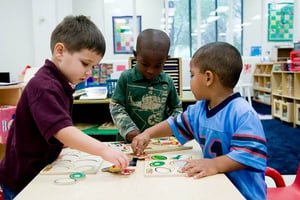 A new report from the American Academy of Pediatrics (AAP) on Children and Adolescents and Digital Media explores new recommendations for children’s media use. The report covers what we currently know about media use and how it affects young children and adolescents and makes recommendations for pediatricians and parents. These recommendations are designed to help adults make good choices that protect the health and safety of children, while understanding that media use is an important part of daily life.
A new report from the American Academy of Pediatrics (AAP) on Children and Adolescents and Digital Media explores new recommendations for children’s media use. The report covers what we currently know about media use and how it affects young children and adolescents and makes recommendations for pediatricians and parents. These recommendations are designed to help adults make good choices that protect the health and safety of children, while understanding that media use is an important part of daily life.
Prior to this report, the AAP recommended that children birth through age 2 have no screen time at all. However, the new report acknowledges how media use has moved away from TV watching, which is usually not interactive, to new digital technologies that promote interaction and social engagement. As parents, families, and even child care providers begin to use apps, videos, and social media to communicate, the AAP understands that children will be exposed to screens before age 1. Because of that, the AAP makes recommendations on how to ensure that children birth through age 2 are able to get the most out of the technology.
The AAP states that while the research shows that there are limited educational benefits of media for children birth through age 2, the research was largely examining TV, which is passive—the child simply sits and watches and/or listens but is not required to interact (see page 4 of the report). Even though new technology offers more opportunity for children to interact with the media, the real key to making sure that the child is learning from the media is to have an adult there to interact with the child and the videos or apps. According to the research, infants and toddlers have “difficulty learning from two-dimensional video representations at younger than 30 months of age … [because b]efore 2 years of age, children are still developing … [skills] which require hands-on exploration and social interaction with trusted caregivers (see page 4 of the report).”
So, the big takeaway is that children birth through age 2 can learn from media, but they learn better and remember what they learn better if there is an adult to interact with them and ask them questions about what they see and hear. More importantly, as children get older (starting at 15 months) they can learn new words from things like touchscreens, but again, without interaction with adults, these children will have trouble transferring knowledge or using it with others.
Many adults will be happy to know that the report also discusses Skyping and other video chatting. The AAP states that because video chatting is usually for a short time, is often used to promote social connections, and adults are typically there to support the child, Skyping is fine to do.
In addition to providing recommendations on whether young children should access media and how they should be supported by adults, the report also talks about what kind of things young children should be exposed to through media and how media impacts how children develop and learn. Research still shows that excessive TV viewing at a young age is linked to delays in cognitive and social emotional development—how they learn and how they get along with others (see page 6 of the report). The authors guess that this might be because children are viewing inappropriate content (that is made for adults or older children) or because there is less interaction between people and the child when the TV is on.
The report authors also found that the more media use reported and the earlier the child started using media is linked to low impulse control and not being able to understand others’ thoughts or feelings (see page 7 of the report). There are also associations between violent media content seen by young children and aggressive behavior. For these reasons, the report recommends that parents limit what their children see and make sure it is not violent (see page 7 of the report). Research has shown that content from the Public Broadcasting Service (PBS) helps improve children’s thinking, language, and social skills. Watching PBS can also help protect a child that has been exposed to violent or inappropriate media. If children who were watching inappropriate shows switch to watching PBS shows, they can experience improvements in their behavior (see page 5 of the report). This is a really exciting point for child care providers—even if children are exposed to inappropriate content at home, what providers expose children to during the day can have a positive impact, which proves how important the decisions are that providers make around whether to use media during the day and if so, which media they choose.
From a policy perspective, it is harder to use these recommendations to make easy policies for child care providers to follow. It is much easier to say “no screen time from birth to age 2” than it is to say “a little screen time with 1:1 or 1:3 provider–child ratios is allowed.” It is also harder to check for compliance with that policy. It is easy to see whether a 2 year old is in a room with a TV or is on a computer, but it is much harder to determine whether the provider is really interacting well with a child when the child is playing a computer game, for example. Much thought will be needed in determining how to implement policies that are research-based, that providers can easily understand and follow, and that monitors can observe consistently.






